
NEVADA KING INTERCEPTS 42.7M OF 4.67 G/T AU INCLUDING 18.3M OF 7.94 G/T AU AT NEW ‘WILD WEST’ ZONE, A STEP-OUT APPROXIMATELY 150M WEST OF THE ATLANTA RESOURCE ZONE

Nevada King Gold Corp. (TSX-V: NKG) (OTCQX: NKGFF) is pleased to announce results from 12 vertical, reverse circulation holes, eight of which were drilled into a new discovery area called the Wild West Zone at its 5,166 hectares (51.6km2), 100% owned Atlanta Gold Mine Project, located in the prolific Battle Mountain Trend 264km northeast of Las Vegas, Nevada. The WWZ target area is interpreted to have a width of 150m to 200m (east-west, open to the west) over a minimum 500m north-south strike length (open to the south). This new zone is located in an area previously thought to be unmineralized on the west side of the West Atlanta Fault #2, which forms the western boundary of the West Atlanta Graben Zone and the Atlanta resource zone (Figures 1-3).
Wild West Zone Highlights:
| Hole No. | From (m) | To (m) | Interval (m) | Au (g/t) | Ag (g/t) |
| AT24WS-83 | 387.1 | 429.8 | 42.7 | 4.67 | 25.3 |
| Includes | 408.4 | 426.7 | 18.3 | 7.94 | 18.3 |
| AT24WS-80 | 373.4 | 408.4 | 35.1 | 2.66 | 6.3 |
| Includes | 390.2 | 399.3 | 9.1 | 5.06 | 8.4 |
| AT24WS-69* | 323.2 | 396.3 | 73.2 | 1.48 | 5.5 |
| Includes | 352.0 | 356.6 | 4.6 | 4.97 | 4.6 |
| And includes | 304.8 | 306.3 | 1.52 | 11.00 | 4.2 |
| AT24NS-193* | 247.0 | 297.3 | 50.3 | 1.29 | 19.2 |
| Includes | 280.5 | 283.5 | 3.0 | 3.72 | 16.5 |
| AT24NS-194* | 257.6 | 300.3 | 42.7 | 2.08 | 18.5 |
| Includes | 266.8 | 272.9 | 6.1 | 6.32 | 40.8 |
Table 1. Highlight holes released today. Mineralization occurs along near-horizontal horizons with true mineralized thickness estimated to be 90% to 100% of reported drill intercept length. *Denotes hole that bottomed in mineralization.
- As shown in Figure 1 below, drilling to date at Atlanta has focused on targeting gold mineralization primarily within the Atlanta Mine Fault Zone highlighted in purple and the WAGZ highlighted in grey. The recent drilling at the WWZ, shown in green, identifies mineralization well beyond the boundaries of the Atlanta resource zone, returning thick intersections of high-grade gold mineralization in a new target area that remains open to the west and south.
- Figures 2 and 3 illustrate the current known dimensions of the WWZ. Bounded by the recent drilling and two historical holes (DHRI-11-11C and KR98-13), the WWZ measures up to 200m in the east-west direction and over 500m in the north-south direction and remains open to the west and south. Highlight intervals exhibit several high-grade intercepts including AT24WS-83 that returned 4.67 g/t Au over 42.7m, including 7.94 g/t Au over 18.3m.
- Mineralization within the WWZ is heavily oxidized and is concentrated along the same near-horizontal unconformity observed in the neighboring AMFZ and WAGZ. Mineralization is hosted within the silica breccia horizon along the unconformity and within a rhyolitic sill and tuffaceous volcanics directly above the silica breccia. We see the same Au-Ag-As-Ba-Mo metals association within the WWZ as is seen in the adjacent WAGZ.
- The WWZ discovery was made based off of a large CSAMT anomaly (Figure 4) and comes on the heels of two additional discoveries made with targeting done by combining CSAMT results with other historical data – the East Ridge discovery (July 16, 2024) and the South Quartzite Ridge discovery (July 23, 2024). Additional details are provided in the WWZ – CSAMT Geophysical Anomaly section below.
- The WWZ is centred on discovery hole AT24WS-69 (1.48 g/t Au over 73.2m including 4.97 g/t Au over 4.6m) that was sited approximately 80m west of the WAF2. Strong gold mineralization was encountered south, west, and northwest of this hole including 60m south in AT24WS-83 (4.67 g/t Au over 42.7m including 7.94 g/t Au over 18.3m), 48m west in AT24WS-80 (2.66 g/t Au over 35.1m, including 5.06 g/t Au over 9.1m), 39m northward in AT24WS-79 (1.56 g/t over 36.6m including 3.79 g/t over 4.6m and bottoming in mineralization), and 108m northwest in holes AT24NS-193 and AT24NS-194, (50.3m of 1.29 g/t Au including 3.72 g/t Au over 3m and 42.7m of 2.08 g/t Au including 6.32 g/t Au over 6.1m, respectively).
- WWZ mineralization remains open to the west. Hole AT24WS-81 was collared 111m northwest of AT24WS-69 and just entered mineralization when it was lost at a TD depth of 436m. Similar geochemistry and alteration encountered at the bottom of the hole confirms that WWZ mineralization remains open to the west, where deeper drilling is required. Hole AT24WS-82, drilled 200m NNW of AT24WS-69 was weakly mineralized, indicating a northern cutoff somewhere between AT24WS-82 and AT24NS-194 for the WWZ.
- WWZ mineralization also remains open to the south. Today’s holes drilled within the WWZ tested an area measuring 250 metres north-south and 200 metres east-west. However, similar geochemical/geophysical signatures were identified from previous drilling in holes DHRI-11-11C and KR98-13, 198m and 248m south of AT24WS-83, respectively. DHRI-11-11C included a high-grade interval of 6.89 g/t Au over 3.0m, while KR98-13 encountered mineralization in the last 1.5m of the hole. These holes extend the length of WWZ to over 500m north-south.
Cal Herron, Exploration Manager of Nevada King, stated, “The 42.7m @ 4.67 g/t Au intercept in AT24WS-83 marks a significant new intercept in an underexplored part of the Atlanta property. This hole comes on the heels of another significant hit in AT24HG-41 (6.28 g/t Au over 54.9m), beneath a barren cap of massive quartzite at the northern end of the South Quartzite Ridge Target (released July 23, 2024). Both holes are located outside of the Atlanta resource zone in areas possessing sparse or no historical drilling and the drill results increase our optimism for further such discoveries at Atlanta. With these higher-grade deeper zones of mineralization developing the Company is now conceptually pursuing the potential for a combination of open pit and underground accessible resources at Atlanta. The Wild West Zone is a new discovery based in large part on drilling a strong geophysical anomaly, and it provides us with new targets to chase southward, southwestward, and to depth — all into untested territory. As a geophysical success story, it bodes well for our current regional reconnaissance drilling program designed to test geophysical targets in previously untested areas. With three new discoveries under our belt – the East Ridge Target, the South Quartzite Ridge Target, and now the Wild West Zone, Nevada King continues to push gold mineralization further north, east, south, and west of the historically-explored Atlanta deposit, and given our drill results to date, the future looks promising for additional discoveries.”
WWZ – CSAMT Geophysical Anomaly
- The WWZ was initially discovered with drill hole AT24WS-69 (1.48 g/t Au over 73.2m starting at 323.2m including 4.97 g/t Au over 4.6m) that was sited approximately 80m west of the WAF2 and 65m west of the nearest historical hole, and was oriented to test a magnetic and CSAMT anomaly interpreted to be a deeply buried igneous stock (Figure 4). The hole targeted the margin of this potential stock, looking for later stage felsic intrusions and associated gold mineralization that might have been emplaced along the stock’s periphery as is seen in the southern end of the WAGZ.
- Of particular interest is that the bottom 42m averaging 1.51 g/t Au is hosted in altered dolomite, marking the first-time gold mineralization over a significant length has been found at Atlanta in this rock type. The massive Ely Springs Dolomite at Atlanta is generally considered dense and impermeable and under normal conditions has been interpreted as an unlikely candidate for gold mineralization. The distribution of dolomite-hosted mineralization within the WWZ tends to coincide with the perimeter of the CSAMT high resistivity zone shown in Figure 4, which suggests the strong decalcification and subsequent mineralization within the massive dolomite is tied to whatever formed the CSAMT anomaly, potentially fluids from a stock at depth. This in turn suggests mineralization in the WWZ may be tied to a different fluid source than the one responsible for mineralizing the Atlanta resource zone, which would explain the very low-grade mineralized zone that tends to separate the WWZ from the WAGZ/Atlanta resource zone. This fall-off in grade along the western margin of the WAGZ was one of the reasons previous explorers assumed gold potential west of the resource zone was low and therefore did not generally pursue this area with deeper drilling.
West Atlanta Graben Zone Highlights:
- Four of the holes reported today were drilled within the northern part of the WAGZ in order to further extend mineralization northward and fully penetrate the mineralized zone in areas where previous holes were unable to go deep enough. AT24WS-70 intercepted 1.43 g/t Au over 67.1m starting at 250m including 4.05 g/t Au over 6.1m, which extended mineralization 25m further to the northwest. Drilled along the western margin of the WAGZ within an area possessing four holes that did not penetrate the mineralized zone, AT23WS-54 successfully intercepted 1.63 g/t Au over 41.2m starting at 301.8m including 6.96 g/t Au over 4.6m. This hole demonstrates the westward continuation of higher-grade mineralization up to the WAF2 that bounds the WAGZ on its western margin.
- AT24WS-77 was sited 30m north of AT24WS-54 but did not fully penetrate the mineralized zone. It did manage to recover within the upper high-grade zone, hitting 0.91 g/t Au over 57.9m starting at 307.9m including 3.17 g/t Au over 3.0m. AT24WS-65 was drilled immediately east of the WAF2, 130m SSE of AT24WS-083 hitting 1.09 g/t Au over 27.4m starting at 355m. This hole is consistent in grade and thickness compared to other holes drilled in this portion of the WAGZ.
| Hole No. | From (m) | To (m) | Interval (m) | Au (g/t) | Ag (g/t) |
| AT23WS-54 | 301.8 | 343.0 | 41.2 | 1.63 | 17.7 |
| Includes | 307.9 | 312.5 | 4.6 | 6.96 | 60.3 |
| AT24WS-70 | 250.0 | 317.1 | 67.1 | 1.43 | 17.9 |
| Includes | 254.6 | 260.7 | 6.1 | 4.05 | 17.6 |
| AT24WS-77* | 307.9 | 365.9 | 57.9 | 0.91 | 9.9 |
| Includes | 347.6 | 350.6 | 3.0 | 3.17 | 10.6 |
| AT24WS-79* | 317.0 | 353.6 | 36.6 | 1.56 | 3.3 |
| Includes | 320.1 | 324.7 | 4.6 | 3.79 | 6.3 |
| AT24WS-81 | NSM | NSM | NSM | NSM | NSM |
| AT24WS-82 | 289.6 | 294.1 | 4.6 | 0.60 | 14.1 |
| AT24WS-083 | 387.1 | 429.8 | 42.7 | 4.67 | 25.3 |
| Includes | 408.4 | 426.7 | 18.3 | 7.94 | 18.3 |
| AT24WS-80 | 373.4 | 408.4 | 35.1 | 2.66 | 6.3 |
| Includes | 390.2 | 399.4 | 9.1 | 5.06 | 8.4 |
| AT24WS-69* | 323.2 | 396.3 | 73.2 | 1.48 | 5.5 |
| Includes | 352.0 | 356.6 | 4.6 | 4.97 | 4.6 |
| Includes | 304.8 | 306.3 | 1.52 | 11.00 | 4.2 |
| AT24WS-65 | 355.2 | 382.6 | 27.4 | 1.09 | 16.3 |
| AT24NS-193* | 247.0 | 297.3 | 50.3 | 1.29 | 19.2 |
| Includes | 277.4 | 283.5 | 6.1 | 3.09 | 15.3 |
| AT24NS-194* | 257.6 | 300.3 | 42.7 | 2.08 | 18.5 |
| Includes | 266.8 | 272.9 | 6.1 | 6.32 | 40.8 |
Table 2. All holes released today. Mineralization occurs along near-horizontal horizons with true mineralized thickness estimated to be 90% to 100% of reported drill intercept length. AT23 series holes drilled by Nevada King in 2023, AT24 series holes drilled in 2024. *Denotes hole bottoming in mineralization.
| Hole No. | NSM |
| DHRI-11-20C | Not deep enough |
| DHRI-11-15C | Not deep enough |
| DHRI-11-NRC01 | Not deep enough |
| DHRI-11-18C | Not deep enough |
| KR98-13^ | Not deep enough |
| AR-26^ | Not deep enough |
| AR-25 | Not deep enough |
| AR-24 | Not deep enough |
| AR-23 | Not deep enough |
| AR-22 | Not deep enough |
Table 3. List of historic holes within the WWZ that did not go to depth of mineralization. DHRI series holes drilled by Meadow Bay in 2011, KR series drilled by Kinross in 1998, and AR series drilled by Goldfields in 1991. ^Denotes angled hole.
| Hole No. | From (m) | To (m) | Interval (m) | Au (g/t) | Ag (g/t) | |
| DHRI-11-19C | 431.3 | 443.5 | 12.2 | 0.23 | 1.58 | |
| DHRI-11-11C | 297.2 | 439.0 | 141.8 | 0.569 | 17.4 | |
| Includes | 423.8 | 426.8 | 3.0 | 6.89 | 30.0 |
Table 4. List of historic holes within the WWZ that intersected the mineralized horizon. DHRI series holes drilled by Meadow Bay in 2011.
QA/QC Protocols
All RC samples from the Atlanta Project are split at the drill site and placed in cloth and plastic bags utilizing a nominal 2kg sample weight. CRF standards, blanks, and duplicates are inserted into the sample stream on-site on a one-in-twenty sample basis, meaning all three inserts are included in each 20-sample group. Samples are shipped by a local contractor in large sample shipping crates directly to American Assay Lab in Reno, Nevada, with full custody being maintained at all times. At American Assay Lab, samples were weighted then crushed to 75% passing 2mm and pulverized to 85% passing 75 microns in order to produce a 300g pulverized split. Prepared samples are initially run using a four acid + boric acid digestion process and conventional multi-element ICP-OES analysis. Gold assays are initially run using 30-gram samples by lead fire assay with an OES finish to a 0.003 ppm detection limit, with samples greater than 10 ppm finished gravimetrically. Every sample is also run through a cyanide leach for gold with an ICP-OES finish. The QA/QC procedure involves regular submission of Certified Analytical Standards and property-specific duplicates.
Qualified Person
The scientific and technical information in this news release has been reviewed and approved by Calvin R. Herron, P.Geo., who is a Qualified Person as defined by National Instrument.
About Nevada King Gold Corp.
Nevada King holds a 100% interest in the Atlanta Mine, Nevada. The Atlanta Mine is a historical gold-silver producer with a NI 43-101 compliant pit-constrained resource of 460,000 oz Au in the measured and indicated category (11.0M tonnes at 1.3 g/t) plus an inferred resource of 142,000 oz Au (5.3M tonnes at 0.83 g/t). See the NI 43-101 Technical Report on Resources titled “Atlanta Property, Lincoln County, NV” with an effective date of October 6, 2020, and a report date of December 22, 2020, as prepared by Gustavson Associates and filed under the Company’s profile on SEDAR+ (www.sedarplus.ca).
| Resource Category | Tonnes
(000s) |
Au Grade
(ppm) |
Contained Au Oz |
Ag Grade
(ppm) |
Contained Ag Oz |
| Measured | 4,130 | 1.51 | 200,000 | 14.0 | 1,860,000 |
| Indicated | 6,910 | 1.17 | 260,000 | 10.6 | 2,360,000 |
| Measured + Indicated | 11,000 | 1.30 | 460,000 | 11.9 | 4,220,000 |
| Inferred | 5,310 | 0.83 | 142,000 | 7.3 | 1,240,000 |
Table 5. NI 43-101 Mineral Resources at the Atlanta Mine
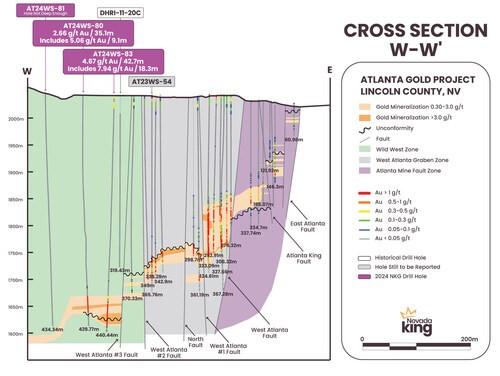
Figure 1. Simplified section W-W’ looking north across the AMFZ, WAGZ, and WWZ denoting mineralized horizons in relation to major structures. High-grade zones exceeding 3 g/t Au are shown in dark pattern within the broader blanket. Today’s highlight hole AT24WS-83 shown at far west side within down-dropped graben. (CNW Group/Nevada King Gold Corp.)
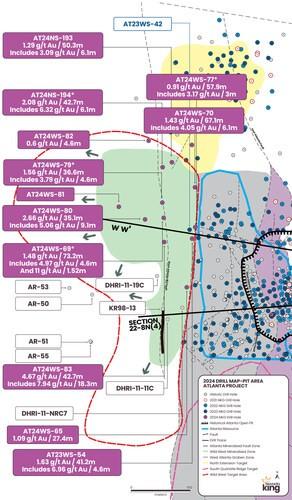
Figure 2. Plan view map of structural domains at Atlanta; AMFZ, WAGZ, NET, and the newly defined WWZ. Holes that did not go deep enough to define mineralization are taken off plot for clarity, as are the dump holes. Vector arrows denote directions in which the WWZ mineralization remains open. (CNW Group/Nevada King Gold Corp.)
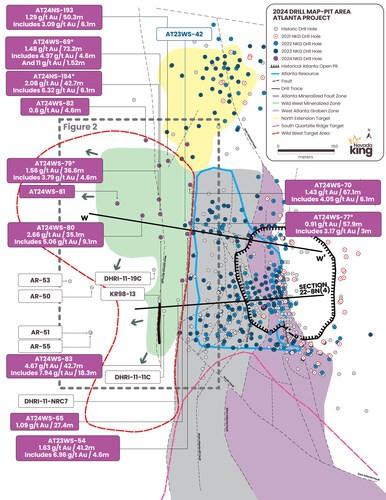
Figure 3. Plan view map of the WWZ, WAGZ, and NET. Holes that did not go deep enough to define mineralization are taken off plot for clarity, as are the dump holes. Vector arrows denote directions in which the WWZ remains open. (CNW Group/Nevada King Gold Corp.)
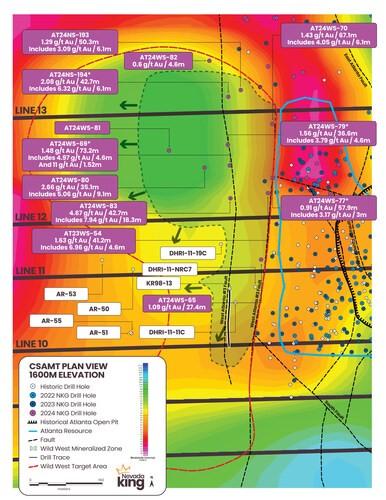
Figure 4. Plan view of WWZ drill holes relative to strong CSAMT anomaly interpreted as a deep intrusive stock (green resistivity high) ringed by a low resistivity (red) fragmental blanket. Of the historical holes drilled south of the anomaly, AR-53 did not go deep enough, while AR-50, 51, and 55 hit weak Au-Ag mineralization in silica breccia along the unconformity with underlying dolomite. (CNW Group/Nevada King Gold Corp.)
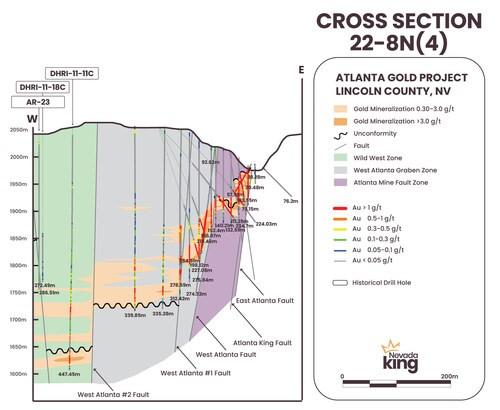
Figure 5. Simplified Section22 8N(4) looking north across the AMFZ, WAGZ, and WWZ denoting mineralized horizons in relation to major structures. High-grade zones exceeding 3 g/t Au are shown in dark pattern within the broader blanket. (CNW Group/Nevada King Gold Corp.)
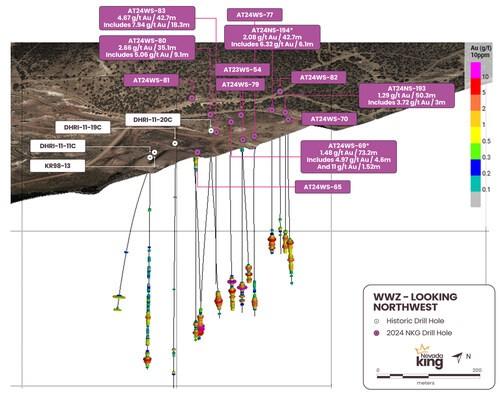
Figure 6. Oblique cross section view looking northwest showing downhole assay intervals of holes released across the WWZ. Holes that did not go deep enough to define mineralization are taken off section for clarity, as are the dump holes. (CNW Group/Nevada King Gold Corp.)
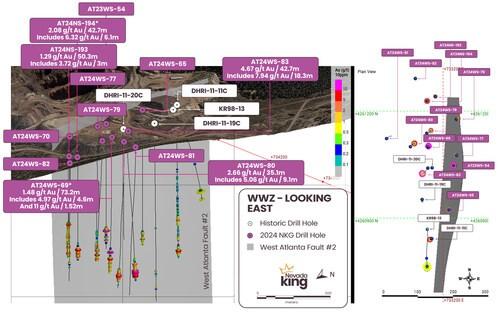
Figure 7. Oblique cross section view looking southeast showing downhole assay intervals of holes released across the WWZ on the west side of the WAF2 shown by the grey fault plane. Holes that did not go deep enough to define mineralization are taken off section for clarity, as are the dump holes. (CNW Group/Nevada King Gold Corp.)
MORE or "UNCATEGORIZED"
Kuya Silver Confirms High-Grade Silver-Gold Vein Mineralization at Umm-Hadid with Initial Drill Results up to 1483.9 g/t AgEq over 2 Metres
Kuya Silver Corporation (CSE: KUYA) (OTCQB: KUYAF) (FSE: 6MR1) is... READ MORE
First Phosphate Closes Final Tranche of Oversubscribed Private Placement
First Phosphate Corp. (CSE: PHOS) (OTCQX: FRSPF) (FSE: KD0) is... READ MORE
GFG Receives Final Payment from the Sale of its Rattlesnake Hills Gold Project
GFG Resources Inc. (TSX-V: GFG) (OTCQB: GFGSF) announces that i... READ MORE
Goliath Receives $1,730,882 Through Warrant Exercises, Inclusive Of Crescat Capital A Longtime Strategic And Cornerstone Shareholder
Goliath Resources Limited (TSX-V: GOT) (OTCQB: GOTRF) (FSE: B4IF)... READ MORE
Robex Pours First Gold at Kiniéro on Schedule and Budget
Highlights: Gold bar weighing 2.64 kilograms (85 oz) poured in th... READ MORE












